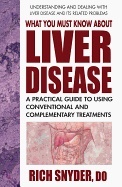Liver disease ranks fourth as a killer of people between the ages of 45 and 64. Unfortunately, without an annual blood test, it can progress silently until the organ's ability to function has been greatly compromised. When a diagnosis of liver disease is given, the road that lies ahead is unfamiliar to most patients and may seem frightening. WHAT YOU MUST KNOW ABOUT LIVER DISEASE is a guide to understanding the disease and its treatment options.
The book is divided into two parts. Part One addresses the conventional approach to the treatment of liver disease. Using nontechnical language, Dr. Snyder begins by explaining the function of the liver and examines the many ways in which the liver can be damaged - from alcohol abuse to overdosing on over-the-counter pain relievers. He, also, provides an overview of the type of care to expect from your healthcare team - including tests, medication and more - and looks at the signs and symptoms of possible complications. Once you know the basics of liver function and conventional treatments, Part Two provides a comprehensive examination of the complementary therapies that can be used in coordination with your ongoing care. The doctor offers information on nutrition and natural supplements - those to take and those to avoid. Finally, he presents an exercise programme designed specifically for liver patients and a Liver-Detoxification Plan that can rid the organ of burdensome substances.
Written in a clear and inviting manner, Dr. Snyder allows patients and their families to better understand what liver disease is and how it can be successfully treated. Most important, WHAT YOU MUST KNOW ABOUT LIVER DISEASE gives patients the information they need to be active participants in their own treatment.


